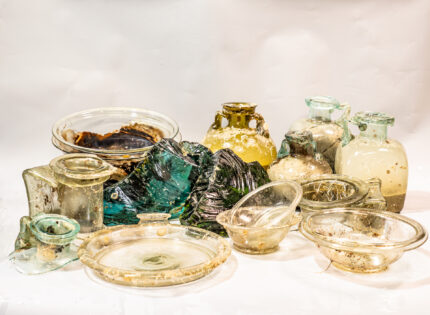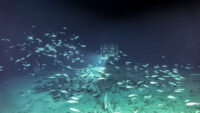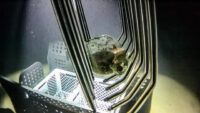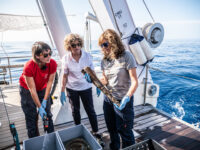 A team of French and Italian underwater archaeologists have recovered a selection of glassware and raw glass blocks from a Roman shipwreck between the Italian island of Capraia and the French island of Corsica. It is only the second wreck found with a cargo that is predominantly glass, both worked pieces and the raw blocks in various sizes and colors ready to blow into commercial tableware. There are thousands of glass pieces and tons of raw blocks on the sea floor from this one ship. The contents of the wreck suggest it took to the sea for the last time in the late 1st century or early 2nd century A.D.
A team of French and Italian underwater archaeologists have recovered a selection of glassware and raw glass blocks from a Roman shipwreck between the Italian island of Capraia and the French island of Corsica. It is only the second wreck found with a cargo that is predominantly glass, both worked pieces and the raw blocks in various sizes and colors ready to blow into commercial tableware. There are thousands of glass pieces and tons of raw blocks on the sea floor from this one ship. The contents of the wreck suggest it took to the sea for the last time in the late 1st century or early 2nd century A.D.
The wreck was found 350 meters (1150 feet) deep in 2012. The location was initially deemed to be in French territorial waters, and the underwater archaeology department of France’s Culture Ministry performed some initial surveys of the site in 2013 and 2015. Diplomatic negotiations on where to draw the border flipped the find site into Italian territorial waters in 2016, and the two countries decided to work on a joint study of the wreck. The first campaign of the joint mission took place the first week of this month.
 The French Culture Ministry contributed its research vessel, the Alfred Merlin, and its two remote operated vehicles to explore the wreck. One of the ROVs, dubbed Arthur, is a new prototype with more functions than a Swiss Army knife. It can operate at depths of up to 2500 meters, shoot high-definition video, blow and vacuum sediment and grab objects to bring them to the surface with its delicate claw system.
The French Culture Ministry contributed its research vessel, the Alfred Merlin, and its two remote operated vehicles to explore the wreck. One of the ROVs, dubbed Arthur, is a new prototype with more functions than a Swiss Army knife. It can operate at depths of up to 2500 meters, shoot high-definition video, blow and vacuum sediment and grab objects to bring them to the surface with its delicate claw system.
 Arthur has recovered an assortment of different glass pieces including bottles, plates, cups, bowls, a small unguentarium (cosmetic vessel) and several raw blocks. In addition to the glassware, two large bronze basins and a few amphorae were brought to the surface.
Arthur has recovered an assortment of different glass pieces including bottles, plates, cups, bowls, a small unguentarium (cosmetic vessel) and several raw blocks. In addition to the glassware, two large bronze basins and a few amphorae were brought to the surface.
At the moment the wreck is dated between the end of the 1st century and the beginning of the 2nd century AD but an in-depth study of the materials will be able to provide further details on the chronology of the shipwreck and more information on the route traveled by the ship on its last journey. At an initial analysis of the load, given the type of visible amphorae (“carrot” amphorae, oriental amphorae including probable Beirut-type amphorae and some Gauloise 4 amphorae) and the quantity of glass vessels and blocks of raw glass, the archaeologists believe that the ship must have come from a port in the Middle East, perhaps from Lebanon or Syria, and that it was headed for the French Provençal coast.
 The amphora shown in the photos is a carrot amphora, named for its distinctive shape. They were produced in Beirut in the late 1st century and first half of the second century A.D. and were used to transport local dates for export to Italy, France, Spain, Germany, the Balkans and even further afield to Britain.
The amphora shown in the photos is a carrot amphora, named for its distinctive shape. They were produced in Beirut in the late 1st century and first half of the second century A.D. and were used to transport local dates for export to Italy, France, Spain, Germany, the Balkans and even further afield to Britain.
The recovered objects will all be transported to the laboratory of the National Superintendence in Taranto where they will be subjected to various scientific analyses and conserved for future display.
This video shows the ROV doing its thing, recording fantastic high-def video of the site, vacuuming sediment and recovering fragile artifacts from the sea floor with its remarkably gentle but effective gripper claws.